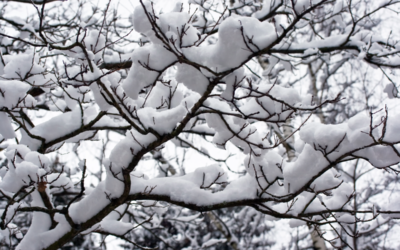Even with a foot or more of snow, Coloradans know most of it will be gone after a day or two of bright mountain sunshine. But if the nights stay cold or the snow is on a protected north side of your property, it can melt or compact into ice, which is when many people reach for the deicer. They don’t realize the damage they’ve done by using this product until the spring, when grass, plants and trees are dead, and walks and driveways are riddled with pits and cracks.
The culprit? Salt.
The Dangers of Salt (Sodium Chloride)
Sodium chloride is the same chemical as ordinary table salt. It’s inexpensive, so it’s the main ingredient in cheaper deicing products. While it will melt ice effectively down to about 10° F, it will also damage concrete, metals, soil and plants if not used carefully.
Risk of Acidic Soil
Dissolved salts are acidic, and acidic soils cause long-lasting damage to lawns, shrubs and trees. Once salt is in the soil, it’s very hard to get out, so the best plan is to keep it away in the first place. Even if the salt is applied only on the hardscape, the water from melting snow and ice will carry it into the surrounding soil. Concrete and mortars are very alkaline, so acidic salts work into the pores, causing pitting and flaking known as spalling, which weakens the entire slab and promotes crack formation. Washing the salt away only encourages it to flow into the landscape or pollute water when it flows into the sewer system or groundwater.
Prevent the Need to Deice by Minimizing Ice Formation
You can minimize ice formation by avoiding walking and driving on snow before it’s removed, preventing its compaction and icing up.
Other Salt-Based Deicing Chlorides to Avoid
If you must use a deicer, be aware that sodium chloride isn’t the only problem. Other salt-based deicing products include chlorides of calcium, potassium, and magnesium.
Calcium chloride is widely used, and while it is less hazardous to vegetation than sodium chloride, as it melts ice it causes the surface to become slippery, presenting a hazard itself. This is popular as a deicer, though, because it’s relatively inexpensive and effective to about -15° F. However, it’s still no friend of concrete and can damage the roots of plants if it reaches them.
Potassium chloride can also cause severe damage to plants if splashed on foliage or allowed to soak into the soil and will damage concrete like sodium and calcium compounds.
Magnesium chloride in the form of calcium magnesium acetate (CMA) has come into widespread use as a safer deicer by road and highway crews. It’s made from limestone and acetic acid (the main ingredient in vinegar) and works differently from other salts in that it prevents snowflakes from sticking to each other. While it has little effect on concrete and vegetation, it’s less commonly available to consumers, is more expensive, and works best at temperatures above +20° F, limiting its effectiveness in many icing situations.
Spot-Treating Icy Areas
Careful spot-treating problem areas can be done if necessary, but should be a last resort. It’s better to risk a little landscape damage than a lawsuit. If the salt solutions run into planted areas, extra hand watering on warm winter days can help diffuse it and minimize damage. Unfortunately, it will probably be late spring before you know how much damage was done.
Conclusion
If you’re concerned about the health of your soils, the plant health and management experts at Donovan Arborists are ready to help. Contact us today to learn about our free estimates for tree care services.




